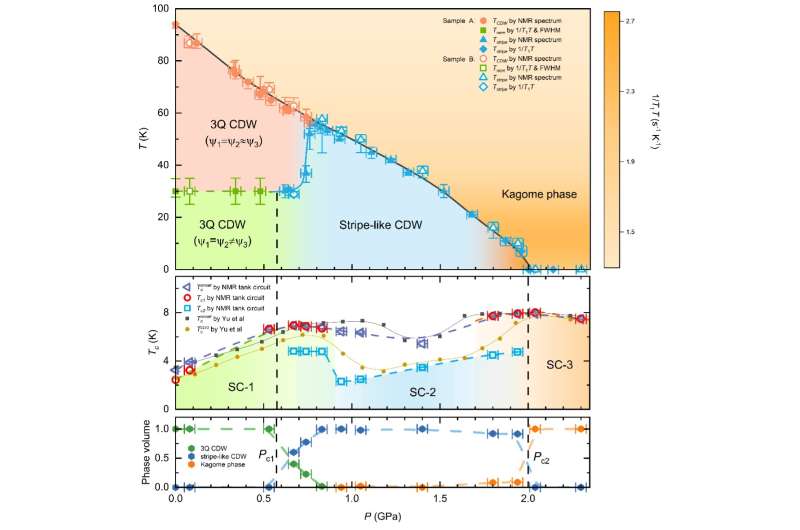Pressure-dependent evolution of superconductivity and CDW state in CsV3Sb5. Credit: Zheng Lixuan et al
Superconductors lose their electrical resistance when cooled below a certain threshold temperature. With their promising application future as well as glamorous physical mechanisms, superconductors appeal to numerous scientists dedicated to this field.
A research team led by Prof. Chen Xianhui from the University of Science and Technology of China (USTC) of the Chinese Academy of Sciences recently reported an emergent charge order competing with superconductivity in the pressurized kagome superconductor CsV3Sb5 by nuclear magnetic resonance (NMR) measurements in a study published in Nature.
The interplay between different ordering tendencies in superconducting materials is complicated. Recently, "intertwined orders" have been proposed from a different perspective that focuses on the cooperation of different orders. One key in this field is to explore the underlying physics of intertwined orders. The discovery of several electronic orders in the kagome superconductors AV3Sb5 (A means K, Rb, Cs) provides a promising platform.
The Japanese word "kagome" means a bamboo basket woven pattern. This pattern of two-dimensional (2D) lattice is endowed with various band structures such as flat bands, Dirac points, and van Hove singularities. Earlier theory has predicted unusual superconductivity and a large variety of electronic orders near the van Hove singularities in a 2D kagome lattice.
Previously, the researchers have illuminated the triple-Q charge density wave (CDW) and a novel electronic nematicity. They also found the unusual competition of superconductivity and CDW state in the pressure experiments.
Based on previous research, the researchers further investigated the evolution of CDW and superconductivity in CsV3Sb5 under pressure. An emergent CDW state was observed between the pressure of Pc1≃0.58 GPa and Pc2≃2.0 GPa, where superconductivity was strongly suppressed. However, when the pressure reached Pc2, the emergent CDW was suppressed and superconductivity dominated. The findings suggest a strong competition between CDW and superconductivity.
Moreover, the nuclear spin-lattice relaxation measurement revealed evidence for pressure-independent charge fluctuations above the CDW transition temperature, suggesting the existence of electronic correlation effects in the 2D kagome lattice. Conventional superconductors showed a Hebel-Slichter coherent peak under the superconducting transition temperature. But this peak was not observed in CsV3Sb5, which indicated a possibly unconventional superconductivity in this pressurized kagome superconductor.
The study reveals the evolution and new electronic correlation effects in kagome superconductors, paving the way for exploring more about their unconventional superconductivity.
More information: Lixuan Zheng et al, Emergent charge order in pressurized kagome superconductor CsV3Sb5, Nature (2022). DOI: 10.1038/s41586-022-05351-3
Journal information: Nature
Provided by University of Science and Technology of China
























